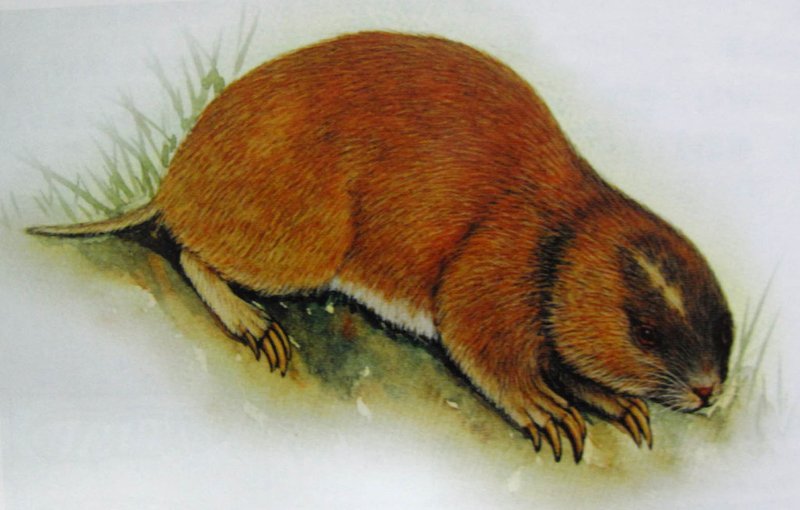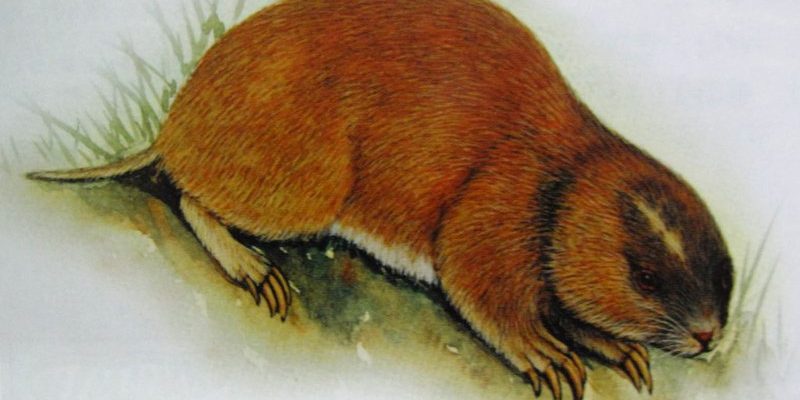
The zokor, a fascinating little creature, may not be the first animal that comes to mind when you think of wildlife, but it certainly deserves your attention. These small rodents, native to Central Asia, are masters of the underground world, spending most of their lives burrowing through the soil. Imagine a tiny wizard, equipped with sharp claws and a big appetite for roots and tubers, crafting elaborate tunnels beneath our feet.
You might be wondering what these critters look like and how they live. Zokors have stout bodies, small eyes, and a velvety fur coat that blends beautifully into their earthy surroundings. This adaptation is essential since they rarely venture above ground. Instead, they rely on their impressive tunneling skills to navigate and thrive in their habitat.
In this article, we’ll dig deep into the world of zokors, exploring their characteristics, behavior, diet, and more. Just like a good conversation over coffee, we’ll uncover the various layers that make this little rodent so interesting!
Physical Characteristics of Zokors
Zokors are compact rodents that typically measure between 8 to 12 inches in length. They have a robust build, with a round body and short limbs, which helps them navigate through their underground dwellings. Their fur is usually a mix of brown and gray, providing excellent camouflage against predators. What truly sets zokors apart, though, are their sharp, powerful claws. These claws are essential for digging through hard soil as they create extensive tunnel networks.
Their eyes are notably small, almost vestigial, as they are adapted to a life spent mostly in darkness. This gives them a unique advantage: they rely more on their sense of touch and smell to navigate through their subterranean homes. Zokors also possess large, protruding front teeth, similar to those of a beaver, which help them gnaw through tough roots and tubers.
In terms of weight, zokors vary from species to species, but they generally weigh between 1 to 2 pounds. Their stoutness and unique adaptations make them well-suited for their underground lifestyle. Just picture them as little digging machines, tirelessly working to expand their burrows and search for food!
Habitat and Distribution
Zokors primarily inhabit the grasslands and steppes of Central Asia, particularly in countries like Mongolia, Kazakhstan, and parts of China. These regions provide the perfect environment: soft, sandy soil that’s easy to dig through and a good supply of roots and tubers to munch on. If you were to imagine a large, grassy plain with a network of intricate tunnels just below the surface, you’d get a good picture of a zokor’s territory.
They thrive in areas with plenty of vegetation, as this not only provides food but also shelter from predators. In these environments, zokors can create complex burrow systems that extend for hundreds of meters. These tunnels are not just for living; they also act like highways for the animals as they search for food and ensure their safety from above-ground threats.
Interestingly, the zokor’s habitat must be moist as well. They rely on the underground humidity, which helps nurture the roots and tubers they consume. So, they’re not just digging around for fun; the conditions below the earth play a crucial role in their survival.
Diet and Feeding Habits
Zokors are herbivores, which means their diet consists mainly of plant material. They have a particular fondness for roots, tubers, and other underground plant parts. Imagine them as dedicated garden architects, meticulously digging up their favorite snacks just below the surface. It’s a remarkable sight, really—these little creatures working tirelessly, foraging for food to sustain themselves and their families.
One interesting aspect of their feeding habits is their ability to consume large amounts of food in a short time. Zokors can eat up to two-thirds of their body weight in a day! This is essential, especially during the colder months when food becomes scarce. They store excess food in their burrows, creating a larder of sorts to see them through tough times.
Their method of foraging involves using their keen sense of smell and touch to locate edible plants. Once they find a tasty morsel, they use their powerful incisors to dig it up. This digging often leads to the creation of larger burrow systems, benefiting not just them but also other animals in the ecosystem. Their activities play a vital role in aerating the soil and promoting plant growth, making zokors a crucial part of their habitat.
Reproduction and Lifecycle
Zokors have a fascinating reproductive cycle, much like other rodents. They typically breed once a year, with the breeding season varying depending on the species and environmental conditions. Female zokors usually give birth to a litter of about 3 to 6 young after a gestation period of around 30 days. At birth, the babies are hairless and blind, relying entirely on their mother for warmth and nourishment.
As the young zokors grow, they develop fur quickly and start to explore their surroundings within the burrow. By about four weeks of age, they begin to venture out and nibble on solid food. This is an essential time for them to learn survival skills, such as how to dig and forage for food. The mother zokor plays a crucial role in teaching her young, ensuring they understand the ins and outs of their underground world.
By the time they are about two months old, young zokors are typically weaned and ready to leave the burrow to establish their own territories. They reach sexual maturity at around six months, ensuring the continuation of their lineage. It’s truly remarkable how these little creatures adapt and thrive in their rugged habitats!
Behavior and Social Structure
Zokors are generally solitary animals, spending most of their time alone in their burrows. However, during the breeding season, they come together to mate, which leads to fascinating interactions. While males and females usually meet only for this purpose, young zokors may stay close to their mother for a short time before venturing out on their own.
When it comes to territorial behavior, zokors can be quite defensive. They often mark their burrows with scent to warn off rivals. These scent markers help establish boundaries and reduce conflicts over territory. Imagine your backyard, only instead of fences, these tiny creatures use their unique scents to draw invisible lines!
While they might seem like reclusive creatures, zokors do have a few adaptations that enable them to communicate. They use low vocalizations to signal threats or other disturbances, which helps alert nearby zokors to potential dangers. This form of communication, combined with their remarkable digging skills, ensures their survival in the wild.
Threats and Conservation Status
Despite their remarkable adaptations, zokors face several threats in the wild. Habitat loss due to agricultural expansion and urban development is one of the most significant challenges. As humans encroach on their territories, zokors lose essential food sources and burrowing grounds, impacting their populations significantly.
Besides habitat loss, zokors are also threatened by predation. Birds of prey and larger mammals often hunt these small rodents, which can quickly lead to declines in their numbers. You might say that they live in a delicate balance, navigating the dangers of their environment while trying to thrive.
At present, many zokor species are classified as least concern by conservation bodies, but their status can change if habitat destruction continues. This highlights the importance of conservation efforts aimed at preserving natural ecosystems and protecting these fascinating creatures. By raising awareness, we can help ensure that zokors remain a vital part of our ecological community for generations to come.
Interesting Facts about Zokors
| Fact | Description |
|---|---|
| Size: | 8 to 12 inches long |
| Weight: | 1 to 2 pounds |
| Diet: | Herbivorous; primarily roots and tubers |
| Lifespan: | Approximately 3-5 years in the wild |
| Habitat: | Grasslands and steppes of Central Asia |
| Reproduction: | Breeds once a year with litters of 3-6 |
| Social Behavior: | Primarily solitary, with some territorial behavior |
FAQ
What is a zokor’s primary habitat?
Zokors primarily inhabit grasslands and steppes in Central Asia. They prefer areas with soft soil that allows them to dig extensive burrow systems, which they use for shelter and foraging for food. These environments provide not only the necessary conditions for their underground lifestyle but also a variety of plant life that serves as their main food source.
How do zokors dig their burrows?
Zokors dig their burrows using their sharp claws and powerful front teeth. This allows them to excavate the soil efficiently, creating complex networks of tunnels that can extend for hundreds of meters. The digging process is essential not only for creating living spaces but also for accessing their favorite roots and tubers.
Are zokors social animals?
While zokors are primarily solitary creatures, they do come together during the mating season. Outside of this period, they maintain a territorial nature, marking their burrows with scent to ward off intruders. This behavior helps ensure that they have enough resources and space to thrive.
What do zokors eat?
Zokors are herbivores, with a diet mainly consisting of roots, tubers, and other underground plant parts. They are adept foragers, using their keen sense of smell and touch to locate food in their underground world. Zokors can consume a significant amount of food daily, which they store in their burrows for later use.
How long do zokors live?
In the wild, zokors generally live for about 3 to 5 years. Factors such as environmental conditions, predation, and availability of food can affect their lifespan. In controlled environments, such as zoos, they may live longer due to the absence of these stressors.
How do zokors contribute to their ecosystem?
Zokors play a vital role in their ecosystems by aerating the soil through their burrowing activities. This not only helps to promote plant growth but also enhances the overall health of their habitat. Their foraging habits can also influence the distribution of plant species in the area.
Can zokors be kept as pets?
While zokors are fascinating creatures, they are not commonly kept as pets. Their specialized needs and burrowing behavior make it challenging to care for them in captivity. They thrive in their natural habitats, where they can dig and forage as they please.
What threats do zokors face in the wild?
Zokors face several threats, including habitat loss from agricultural expansion and urban development. Additionally, they are susceptible to predation by birds of prey and larger mammals. It is crucial to conserve their natural habitats to protect these unique rodents.
How do zokors communicate?
Zokors communicate primarily through low vocalizations. These sounds help alert other zokors to potential dangers in their environment. Although they are not highly social animals, their ability to convey important information through vocal signals is essential for their survival.
Are zokors endangered?
Many zokor species are currently classified as least concern, but their status can change due to habitat destruction and other factors. It is essential to raise awareness and promote conservation efforts to ensure their populations remain stable and healthy.
What adaptations do zokors have for their underground lifestyle?
Zokors have several adaptations for their underground life, including powerful claws for digging, small eyes suited for low-light environments, and a keen sense of smell and touch. These adaptations enable them to thrive in their subterranean habitats and efficiently forage for food.

